Backstage with Bon Jovi: Exclusive!
Join us as we gain exclusive backstage access with the New Jersey titans during their Lost Highway 2008 tour.
As the only mega-selling US rock band to be regular visitors to the UK and Europe, Bon Jovi - who have sold in excess of 120 million albums, remember - have always put their considerable amounts of money where their perfectly-formed mouths are and although they are dragging both a rhythm guitarist and a violin player around this time, they were already 90 shows into the Lost Highway tour as they landed at Bristol´s Ashton Gate stadium at the end of June. It's hard work!
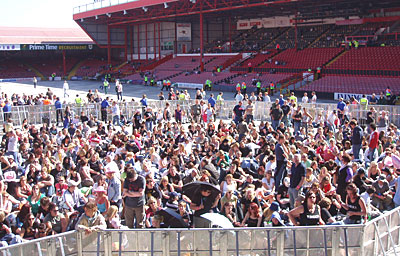
We´re here as guests of Michael Kaye, guitar tech to the stars and a 30 year vet of myriad tours. He´s now responsible for overseeing all the guitar areas of Jon Bon Jovi himself and rhythm guitarist Bobby Bandiera and, as these guys usually are, is calm, friendly and accommodating in the extreme.
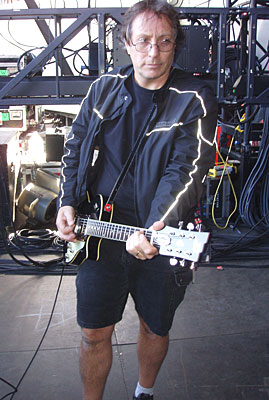
The mighty Michael Kaye
He meets us at the gate with passes, wristbands and tickets in hand and ushers us without any fuss under the enormous stage that lurks at one end of the stadium. To say the expanse beneath the actual performance area itself its overwhelming in size would be to miss the perfect opportunity to describe it as ‘gargantuan´: this is big business and explains why Bon Jovi tours are always high on the list of that year´s biggest-grossing tours.
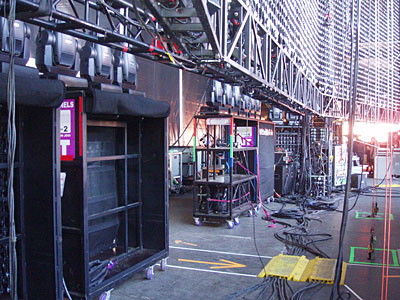
Sorry, where's catering again...?
We start the nickel tour (as Michael puts it) at Jon Bon Jovi´s guitar rack, which includes a number of Takamine acoustics in varying tunings, plus two black Custom Shop Fender Teles and his world-famous white mike stand...
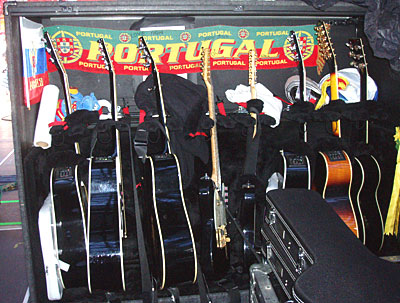
Jon Bon Jovi's guitars of choice: calm down girls...
From there we´re ushered to Richieworld, guitarist Richie Sambora´s area which holds his amp racks, both guitar displays and his personal tech Takumi, yet another very nice guy, fresh from a nine-year stint with Prince.
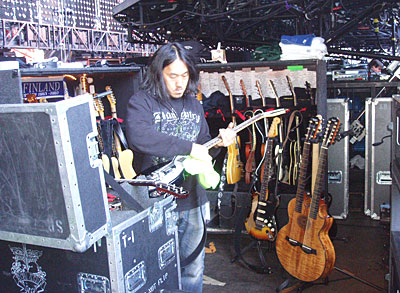
Takumi hard at work in Richieworld
As befits such a player, the rack holds numerous guitars plus two that we were surprised he lets out of his vault: an original 1958 Gibson ES-335 and, even rarer, a 1954 Gibson Les Paul Junior with a maple body. To be fair, both made an appearance later on during the show, so it's not all showboating.
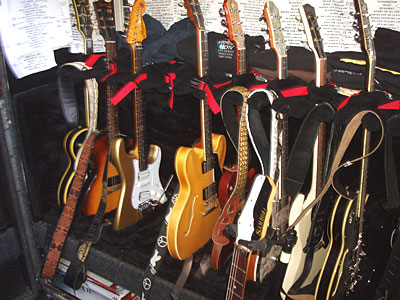
l-r: 1968 Gibson Les Paul Custom, maple-bodied 1954 Gibson LP Junior, the Matthias Jabs 'Mastercaster', original Zemaitis, Japanese Zemaitis, Gibson SG Junior, Duesenberg Starplayer TV
As well as a pair of Zemaitis guitars, one an original and the other a Japanese reissue, was a gold h/s/h Strat made by a workshop close to Scorpions guitarist Matthias Jabs, plus a Custom Shop tri-sunburst Strat that boasts not two but three vertical pickups, and a double-necked Fender Tele complete with capo on the top neck.
Get the MusicRadar Newsletter
Want all the hottest music and gear news, reviews, deals, features and more, direct to your inbox? Sign up here.
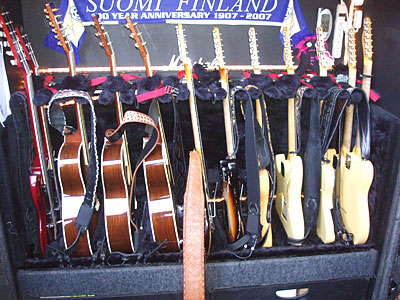
l-r: Gibson ES-1275, Martin RS 12-string, two Martin RS six-strings, Fender Custom Shop Tele, Fender Custom Shop Strat with three vertical pickups, two further Custom Shop Fender Strats, yet another Fender Custom Shop Tele, the Custom Shop Fender Tele double-neck
As well as the Chris Hofschenider-designed signature guitar, plus a new ESP LTD SA-2 Sambora model based upon that very instrument was a Taylor Solidbody, albeit with a typically Samboraesque twist - the provision of a Floyd Rose whammy. “You guys did an article on the Solidbodies, right?” comments Michael. Sure did, sir!
Keeping a pair of Martin acoustics company was the over-the-top double neck Taylor acoustic of yore wheeled out, as ever, for that song about being a cowboy that everyone seems to hate (but we love!). This is stadium rock, people; it´s supposed to be brash and in-yer-face!
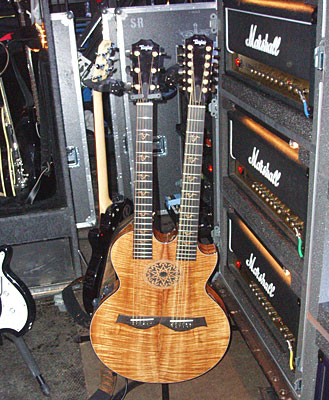
The Taylor double-neck and a brace of Marshall DSL heads: happy bedfellows
Sambora has used a lorry load of different amps over the years and, after dallying with Fender Tonemasters and numerous Diezel amps (“Too many knobs.” Says Michael with a shake of the head), he´s come back full circle to Marshall: a brace of DSL heads to be precise.
The signal is split between an isolation cab beneath the stage and a 4x12 up top, customised with a ‘Sambora´ logo. In fact, all his cables also bear the man´s name: it´s a fame game after all!
The rest of the band use an in-ear monitoring system but, as Richie likes to ‘feel´ the music, he has a number of traditional monitors that flank his guitar cab.
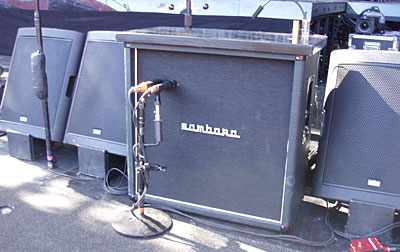
Richie's on-stage cab flanked by his personal monitoring system
Sambora´s effects board includes a number of pedals that Richie changes “...on a daily basis...” and this time around he´s discovered - and is using - the wondrous Klon Centaur alongside an EXH Micro POG and Dunlop Uni-Vibe. “The Uni-Vibe used to be on the whole time, but he´s calmed down a bit now.” Says Michael.
No Bon Jovi gig would be complete without the good old talk box, and Sambora uses two Fulltone Framptones that are sited just beneath the stage. Amongst Tumi´s many duties is to reposition the relevant mike stand whenever a song calls for it: multi-tasking is a basic requirement!
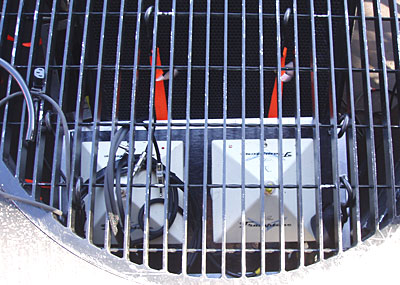
Two Framptone talk boxes. Altogether now: "Tommy used to work on the docks...!"
We got a chance to actually go on stage and got an idea of what it must be like to actually play a stadium. At 23,000 capacity, Ashton Gate is actually quite small in BJ terms (they were due to play two sold out nights at Twickenham two days after our visit - that amounts to 160,000 punters. Phew!).
There are ego ramps galore...
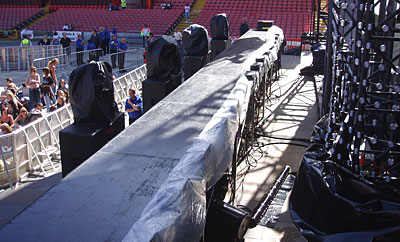
Look at me! Look at ME!!
...and soon it´s time for us to leave. Any chance of meeting Richie, if just for a five minute chat?
“Well, usually the first we see of the band is about ten minutes before showtime. They fly in, play, and then fly out again.” Explains Michael, with no trace of bitterness. Fair ‘nuff.
We shake hands and make our way to the Golden Circle area our pink wristbands have allowed us access into. Top!
Two hours later, the band climb the stairway to glory...
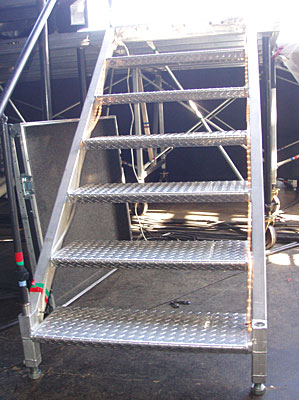
...and the magnificence begins...!
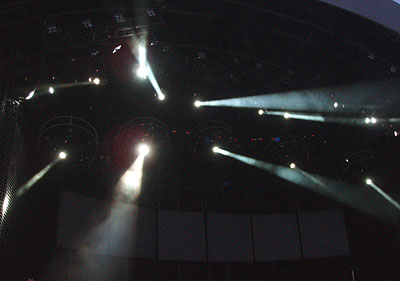
Simon Bradley is a guitar and especially rock guitar expert who worked for Guitarist magazine and has in the past contributed to world-leading music and guitar titles like MusicRadar (obviously), Guitarist, Guitar World and Louder. What he doesn't know about Brian May's playing and, especially, the Red Special, isn't worth knowing.
“Even my cat is disappointed in me”: Deadmau5 gets drunk at Coachella, falls over, is escorted off stage by security, and apologises
“They didn’t like his bikini underwear”: Prince’s support sets for the The Rolling Stones in 1981 are remembered as disastrous, but guitarist Dez Dickerson says that the the crowd reaction wasn’t as bad as people think









